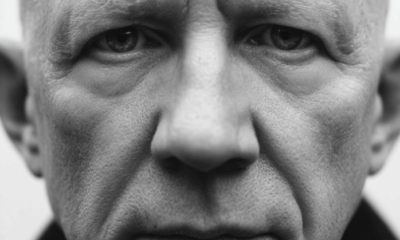Success Advice
14 Ways To Build The #1 Meetup In Your City

Running a Meetup event can be hard work and building an audience can be even harder. To make life easy I decided to interview Dom and Karina McKenna who have the number one Meetup in Melbourne called “The Entrepreneur Club.”
There are currently more than 6000 members, and the Meetup has become very well known in Australia. Dom is also the co-author of the #1 Amazon Best Seller “Defining Moments Of Courage,” which has an introduction written by Jack Canfield.
Together, Dom and Karina are what I consider to be a power couple, and they originally met on the Gold Coast in their early 20’s after both making the decision to live a sober life. Before they met, they were both struggling from drinking too much alcohol and were sick and tired of being sick and tired and not being able to break out of that lifestyle.
They applied the principles of the slight edge, which teaches how your habits run your life. They realized they were either getting better, or they were getting worse, so they decided it was time to take the fork in the road and embark on a journey of personal development.
“Rock bottom became the solid foundation which I rebuilt my life” – JK Rowling
The two of them are one of the most amazing couples you will meet, and they have overcome alcoholism to go on inspire others through their events and youth programs. They believe that sometimes you have to do things that don’t serve you, but that serve others. This is the whole reason Dom and Karina do what they do.
As they began to rebuild their lives and learn to grow again, their business and their Meetup event also grew with them. The Entrepreneur Club now attracts the likes of Scott Harris – who delivers Tony Robbins programs – to Paul Sidoroski, who made it onto the BRW Rich List with his company Sidcor.
Dom and Karina were drawn to running a Meetup around entrepreneurs because entrepreneurs play life at a higher level, are open to new ideas and have a creative mind.
Below are Dom and Karina’s fourteen ways to build a number one meetup in your own city.
1. Don’t make your Meetup too niche
Before doing anything, pick a category for your Meetup that resonates with you. When you’re coming up with the name for your Meetup don’t make it to niche for example “Yarraville Sunday Morning Bike Club.” Ask yourself, how many Yarraville residents are going to be around on Sunday that also happen to ride bikes.
There might be a few, but the audience will be too small. Keep the name of your event broad and like ‘The Entrepreneurs Club,” which is very broad. A name like that will capture anybody who has any sort of entrepreneur desire or is already an entrepreneur.
There might be a few, but the audience will be too small. Keep the name of your event broad and like ‘The Entrepreneurs Club,” which is very broad. A name like that will capture anybody who has any sort of entrepreneur desire or is already an entrepreneur.
“Treat your Meetup like a business. The Meetup is about your audience not about you”
2. Let the audience build
Dom and Karina have seen people that have Meetups where they only had 80 or 90 members and out of that, only ten showed up. The organisers of these Meetups are shocked, and Dom says to them, “you need to let the numbers build and this takes time.” In the case of The Entrepreneur Club, they had 400 members in 2011, then on March 2013 they had 1300 members and now they have over 6000 members.
Like anything you will learn in success, you have to just start doing something and the same goes for Meetups – just start. Karina said that when they only had a small number of people coming she often wasn’t sure what the point was, but both of them learned to have patience and keep persisting.
3. Stay consistent
Once you do your first one, you just have to keep doing it and see it for what it could be not what it is right now. When people RSVP to a Meetup, only 30-40% will actually show up. Your Meetup should go for around two hours, so it’s not too long, and you should always give people the option to leave after they sign in so they don’t feel locked in.
To stay consistent, you need to be looking at either monthly or fortnightly events.
4. Think about a combination of free and paid
Using Garry Vaynerchuks philosophy of Jab Jab Jab right hook, don’t charge too early into running Meetups and provide value first before taking a right hook and asking someone to pay. Try having your event free most of the time and just having the odd one where you charge $10-25.
Once you have done this, you will gauge what people are willing to pay and what affect it will have on audience numbers.
From here you can decide how to proceed. I find that most Meetups these days are free. If you decide to start charging at some point, it’s a good idea to find ways to add more value to the audience like paying a speaker or two to get some bigger names now and then.
5. Structure your marketing
Once you list an event on Meetup, it will push out the details to the members of your group. As you start listing events after that, it will do reminders at specific times to help maximise your attendance. Two weeks after you list the event it’s a great idea to do a scheduled message to your group to do a bio on the upcoming speaker at the next event.
For each Meetup, you should be sending out a total of around three to four messages to your members. Most organisers don’t do this, and that’s part of the reason they don’t get the same numbers as Dom and Karina.
To supercharge this further, create a Facebook Page and get an at home photographer to take some photos. Photos will help to create that social proof that your event exists and people come to it. After your event upload the photos to your Meetup and social media platforms.
6. Keep an eye out for feedback
The Meetup platform has a rating system, which Dom and Karina take very seriously. The better the quality of speakers, the more likely you will get higher ratings. Before people go to a Meetup, they tend to check out your ratings to see what other people say.
One thing that Karina does is making sure she is interacting at the event and getting the feedback as it happens. This allows her to make changes in real time and address any concerns so that it doesn’t get to the point of someone feeling like they have to give negative feedback to be heard.
Karina says that when she and Dom are calm, people don’t tend to stress out as much if anything does go wrong.
7. Secure a venue at no cost
Try to have a venue that you usually use and a few backups just in case. Most venues have a minimum spend in order to have them booked for a Meetup so you need to remind people that are attending, if they could politely purchase a drink or some food, it helps to keep the event going.
“Being a lean startup is cool but being a lean tight-arse is not” – Dom McKenna
If you run your event well, you should almost always meet the venues minimum spend but there are times when you may have to pay the gap out of your own pocket so be prepared for that. The easiest way to get a venue at a low minimum spend is to pick a time of the week when the venue is open but has a very low number of people like a Wednesday night after work.
8. Attract draw card speakers
Dom and Karina will often run into prospective speakers at other events. Their philosophy is people recommend people, which can sometimes be considered to be the old school way of networking nowadays. Once you have had a speaker make sure you ask them for referrals to other speakers.
It goes without saying that you need to let a prospective speaker know the value of them giving up their time to come along. Tell them that they will get to have their brand exposed to your database and interact with prospective fans of their business.
As well as the branding benefits make sure you play on the fact that speaking at your event will allow them to give back and inspire other people to follow a similar journey to them. Everybody loves to come along to something and speak about what they do – we all have egos even if we don’t like to admit it.If your Meetup is going to be run in a big city, then try to attract speakers from the area who have great stories.
When running a free Meetup event, the general expectation is that you wouldn’t pay for the flights and accommodation of the speaker. If you get a no because of this, the other avenue you could take if the speaker travels a lot is to line up the time that they speak with something else in their calendar that’s at a local location.
Expect that the more high profile the speaker is, the longer it will take to get a hold of them and lock them down for the Meetup.
9. Plan well in advance
Once the venue is booked, it’s then time to go to the speaker and confirm if they can attend on the date you have the venue booked. Having the Meetup listed as soon as possible is one of the most important things you need to do. A lot of Meetup organisers fail because they don’t give their audience enough lead-time between events.
Listing a Meetup today that is going to be next week, will guarantee you of failure because you can’t build numbers this way.The minimum lead-time you should aim for is 4-6 weeks before an event and ideally, for a big event, 6-8 weeks.
This allows people to log on, have a look, forward the invite and tell their friends – people refer people, and it takes time. On the night of the event, you should have a registration sheet that you can hand out so you can capture people’s information. A major part of the intellectual property of any business or event is the database.
10. Have killer sound
You must check with the venue what audiovisual equipment they have and whether they can have things like two microphones plugged in or a powerpoint presentation. Be prepared that a microphone might die and always have a backup if you can, or at least a spare pair of batteries for the wireless ones. Most venues should have a sound person so make sure you engage them beforehand and at least do a sound check.
The purpose of the soundcheck is to get the volume right and have their sound person equalise the room to remove any harsh frequencies that could create feedback through the mic. If you’re going to have music playing during the networking part, make sure that it’s not overwhelming, and people can hear their conversations. The choice of music should cater to people’s taste at the Meetup and not be too offensive.
11. Partner with sponsors
The idea of having sponsors can be valuable for your Meetup but one mistake organisers make is they don’t realise that you have to have a certain size audience before sponsors are interested. With 150 members, you probably won’t get support but once you have over a thousand you very well might have some interest.
When you are plugging sponsors in return for their sponsorship dollars, Dom says try not to plug them in every single message that you send to your members. You should have your sponsors logos on your site and maybe a tasteful banner at the event. Once a month it’s a good idea to do a mail out on behalf of a single sponsor to mention or promote what they do.
Monthly mentions of your sponsor will ensure that you don’t overdo it but that you are also providing value in return for their money.
12. Know when to provide food and drink
If you’re running a Meetup that is 90 minutes or less, then you are not really expected to provide food or drink but sometimes that can be affected by the culture of the country that you are in. If you are running a longer event, then it’s a good idea to consider having some food and drink but the catering will most likely need to be paid for by a sponsor.
Typically you don’t charge patrons at your event for food and drink. You need to remember that if your audience are coming straight from work they probably haven’t eaten so providing a small amount of catering will help keep people at your Meetup.
Catering also helps people network because even if they are drinking soda water, the drink allows them to feel comfortable and can be a great excuse to leave a boring conversation and get another drink if required. Having said all of that, the content and the people should be the focus of your Meetup, not the catering.
13. Create a networking environment
Your Meetup needs to be structured in such a way that it allows networking. Karina says the best practice that they follow is to have networking at the start, a speaker in the middle for forty-five minutes and then networking at the end. You should build in fifteen minutes at the end of the speaker talking, for the audience to ask questions.
Once this is over it’s ideal if the speaker sticks around to network, which will help the shy people, ask their burning questions and make the patrons hang around longer. This is not always possible though because some speakers – especially high profile one’s – must leave straight after.
The Meetup shouldn’t be a Friday night at the pub where people only talk with their friends. As the organiser, go around and talk to people because that’s what people want, and they are there to network. It’s for this reason that Dom and Karina have two hours for networking and a speaker for only forty-five minutes.
If you see anyone in the corner not talking to anyone, try and get them involved in a conversation. Networking at a Meetup is not about trying to throw up on people with your business pitch, it’s about meeting people.
“The business relationship is built after the relationship so just slow down to speed up” – Karina McKenna
14. Collaborate with other Meetups
If your event fits within a particular niche try and collaborate with some other Meetups that are in the same market. Don’t see competitor Meetups as your enemy but rather as your friend. The easiest way to do this is to help promote their events to your members and vice versa.
This is an easy way to grow your reach quickly just make sure that their beliefs and values of the other Meetup align with your event that will serve the greater community.
If there is more than one synergy with another Meetup then try having them come to your event and interview someone, and then you do the same for them. If you lose the scarcity mindset, your competitors in the Meetup space can help you succeed even further
***Final thought***
Dom – Don’t underestimate the power of personal development within yourself and the potential that you have. People get so caught up in the small stuff. You need to keep a long-term view of where your life is heading.
Stay true to your values and continue to focus on your goals, serving other people and working on key relationships, and then your life gets better and better. That all starts with you and continuing to put the right input into your mind, which will result in you having a better life
Favourite Book: Jeff Olson – The Slight Edge
Karina – Be kind to yourself and be kind to others because your environment and your situation are really just a reflection of who you are and the person you are becoming. Just remember one thing, if you sit there and think about it the whole time nothing will happen. The only time anything will happen is if you start taking action.
Favourite Book: Dale Carnegie – How to Win Friends And Influence People
Visit The Entrepreneur Club if you would like to know more about Dom and Karina’s Meetup.
Did You Know
How Skilled Migrants Are Building Successful Careers After Moving Countries
Behind every successful skilled migrant career is a mix of resilience, strategy, and navigating systems built for locals.

Moving to a new country for work is exciting, but it can also be unnerving. Skilled migrants leave behind familiar systems, networks, and support to pursue better job opportunities and a better future for their families. (more…)
Life
10 Research-Backed Steps to Create Real Change This New Year
This New Year could finally be the one where you break old patterns and create real, lasting change.

Every New Year, we make plans and set goals, but often repeat old patterns. (more…)
Change Your Mindset
The Silent Skill That Makes People Respect You Instantly
What truly earns respect and why most people go about it the wrong way

Everybody craves respect but not everyone earns it. Some people believe that a title, years of experience, or a position of authority automatically entitles them to respect. (more…)
Entrepreneurs
The Essential Skills Every Entrepreneur Needs In 2026
Success in the digital age isn’t about luck. It’s about mastering the skills that separate dreamers from doers.

When I was 22 years old, I started my first side hustle as a ghostwriter. (more…)
-

 Shift Your Mindset4 weeks ago
Shift Your Mindset4 weeks ago11 E’s That Define Every Great Leader And Why Most People Miss Them
-

 Did You Know4 weeks ago
Did You Know4 weeks agoThe Success Patterns You Inherited (And Didn’t Notice)
-

 Entrepreneurs3 weeks ago
Entrepreneurs3 weeks agoThe Essential Skills Every Entrepreneur Needs In 2026
-

 Business4 weeks ago
Business4 weeks agoThe Hidden Money Pit in Your Operations (and How to Use It)
-

 Change Your Mindset2 weeks ago
Change Your Mindset2 weeks agoHow to Turn Your Mind Into Your Greatest Asset (Instead of Your Enemy)
-

 Change Your Mindset2 weeks ago
Change Your Mindset2 weeks agoThe Silent Skill That Makes People Respect You Instantly
-

 Life2 weeks ago
Life2 weeks ago10 Research-Backed Steps to Create Real Change This New Year
-

 Tech1 week ago
Tech1 week agoWhat’s in a Name? How to Get Your Domain Right




















4 Comments